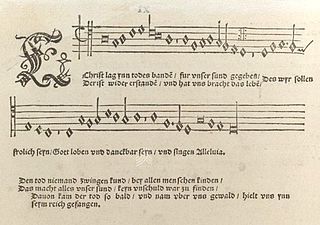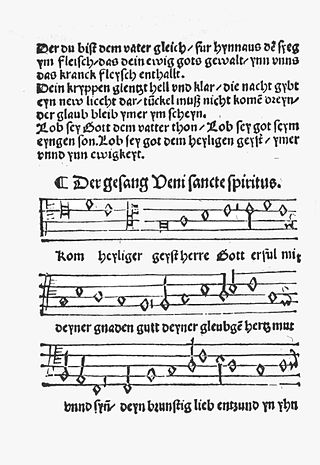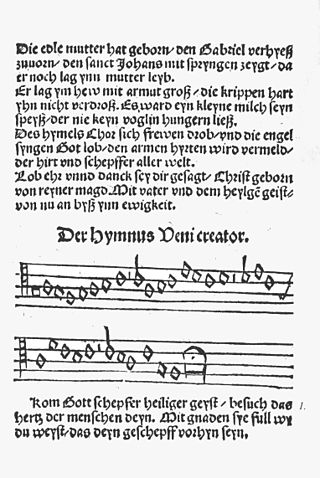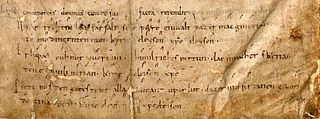
Emilie Juliane was a German countess and hymn writer.
"Wär Gott nicht mit uns diese Zeit" is a Lutheran hymn, with words written by Martin Luther based on the Psalm 124. The hymn in three stanzas of seven lines each was first published in 1524. It was translated to English and has appeared in 20 hymnals. The hymn formed the base of several compositions, including chorale cantatas by Buxtehude and Bach.

"Christ lag in Todesbanden" is an Easter hymn by Martin Luther. Its melody is by Luther and Johann Walter. Both the text and the melody were based on earlier examples. It was published in 1524 in the Erfurt Enchiridion and in Walter's choral hymnal Eyn geystlich Gesangk Buchleyn. Various composers, including Pachelbel, Bach and Telemann, have used the hymn in their compositions.
Media vita in morte sumus is a Gregorian chant, known by its incipit, written in the form of a response, and known as "Antiphona pro Peccatis" or "de Morte". The most accepted source is a New Year's Eve religious service in the 1300s. Reference has been made to a source originating in a battle song of the year 912 by Notker the Stammerer, a monk of the Abbey of Saint Gall: however, the Synod of Cologne declared in 1316 no one should sing this without prior permission of the residing bishop.

"Nun bitten wir den Heiligen Geist" is a German Christian hymn. The first stanza is a leise from the 13th century which alludes to the Latin sequence Veni Sancte Spiritus for Pentecost. It was widely known, and aside from its Pentecostal origin was also used as a procession song and in sacred plays.

"Herr Christ, der einig Gotts Sohn" is a Lutheran hymn by Elisabeth Cruciger. Printed in 1524 in the Erfurt Enchiridion, together with 18 hymns by Martin Luther, it is one of the oldest Lutheran hymns. The text combines Lutheran teaching with medieval mysticism. It has been the basis of musical settings such as Bach's chorale cantata Herr Christ, der einge Gottessohn, BWV 96.

"Komm, Heiliger Geist, Herre Gott" is a Lutheran hymn for Pentecost, with words written by Martin Luther based on "Veni Sancte Spiritus, reple tuorum corda fidelium". The hymn in three stanzas was first published in 1524. For centuries the chorale has been the prominent hymn (Hauptlied) for Pentecost in German-speaking Lutheranism. Johann Sebastian Bach used it in several chorale preludes, cantatas and his motet Der Geist hilft unser Schwachheit auf, BWV 226.
"Vater unser im Himmelreich" is a Lutheran hymn in German by Martin Luther. He wrote the paraphrase of the Lord's Prayer in 1538, corresponding to his explanation of the prayer in his Kleiner Katechismus. He dedicated one stanza to each of the seven petitions and framed it with an opening and a closing stanza, each stanza in six lines. Luther revised the text several times, as extant manuscript show, concerned to clarify and improve it. He chose and possibly adapted an older anonymous melody, which was possibly associated with secular text, after he had first selected a different one. Other hymn versions of the Lord's Prayer from the 16th and 20th-century have adopted the same tune, known as "Vater unser" and "Old 112th".

"O Welt, sieh hier dein Leben" is a Lutheran Passion hymn in German by Paul Gerhardt. In 16 stanzas of 6 lines, it was first published in 1647 in Johann Crüger's Praxis pietatis melica. The hymn is known as the source for chorales in Bach's Passions. It was translated to English in several versions, for example "O, World! behold upon the tree" by Catherine Winkworth in 1858.

"Christ ist erstanden" is a German Easter hymn, and is possibly the oldest Christian liturgical German song. It has inspired the music of numerous composers, such as Ludwig Senfl and Heinrich Schütz, as well as modern composers such as Oskar Gottlieb Blarr and Enjott Schneider, and has appeared in 45 hymnals, including the current German Catholic and Protestant hymnals. Translations and paraphrases include a version by Catherine Winkworth which has appeared in 231 hymnals. "Christ ist erstanden" also inspired Martin Luther to write "Christ lag in Todes Banden", deriving the melody from it.
"Jesus Christus, unser Heiland, der von uns den Gotteszorn wandt" is a Lutheran hymn in ten stanzas by Martin Luther for communion, first published in 1524 in the Erfurt Enchiridion. It is one of Luther's hymns which he wrote to strengthen his concepts of reformation. The models for the text and the melody of Luther's hymn existed in early 15th-century Bohemia. The text of the earlier hymn, "Jesus Christus nostra salus", goes back to the late 14th century. That hymn was embedded in a Hussite tradition.

"Gott sei gelobet und gebenedeiet" is a Lutheran hymn of 1524 with words written by Martin Luther who used an older first stanza and melody. It is a song of thanks after communion. Luther's version in three stanzas was printed in the Erfurt Enchiridion of 1524 and in Johann Walter's choral hymnal Eyn geystlich Gesangk Buchleyn the same year. Today, the song appears in German hymnals, including both the Protestant Evangelisches Gesangbuch, and in a different version in the Catholic Gotteslob.

"Komm, Gott Schöpfer, Heiliger Geist" is a Lutheran hymn for Pentecost, with words written by Martin Luther based on the Latin "Veni Creator Spiritus". The hymn in seven stanzas was first published in 1524. Its hymn tunes are Zahn No. 294, derived from the chant of the Latin hymn, and Zahn No. 295, a later transformation of that melody. The number in the current Protestant hymnal Evangelisches Gesangbuch (EG) is 126.

The Leise or Leis is a genre of vernacular medieval church song. They appear to have originated in the German-speaking regions, but are also found in Scandinavia, and are a precursor of Protestant church music.

"Es woll uns Gott genädig sein" is a Lutheran hymn, with words written by Martin Luther based on the Psalm 67. The hymn in three stanzas of nine lines each was first published in Wittenberg in 1524. Its best known hymn tune, Zahn No. 7247, was published in Strasbourg in 1524. Heinrich Schütz and Johann Sebastian Bach wrote settings of the hymn. It was translated to English and has appeared in dozens of hymnals.
"Herr Jesu Christ, wahr Mensch und Gott" is a Lutheran hymn by Paul Eber. It is a hymn for the dying. One of the hymn's tunes, Zahn No. 423, is also used for "Wir danken dir, Herr Jesu Christ".

"Allein Gott in der Höh sei Ehr" is an early Lutheran hymn, with text and melody attributed to Nikolaus Decius. With the reformers intending church service in German, it was intended as a German version of the Gloria part of the Latin mass, used in almost every service. Decius wrote three stanzas, probably in 1523, while a fourth was added, probably by Joachim Slüter.

"Dies sind die heilgen zehn Gebot" is a hymn by the Protestant reformer Martin Luther based on the Ten Commandments. It appeared first in 1524 in the Erfurt Enchiridion.

"Liebster Jesu, wir sind hier" is a Lutheran hymn with text written by Tobias Clausnitzer in 1663, and a hymn tune, Zahn No. 3498b, based on a 1664 melody by Johann Rudolph Ahle. A prayer for illumination, it is suitable for the opening of a church service and to be sung before a sermon. The song is part of the Protestant hymnal Evangelisches Gesangbuch as EG 161. It is also part of the Catholic hymnal Gotteslob as GL 149. It is popular also in English translations such as "Blessed Jesus, at your word" by Catherine Winkworth.

Mitten wir im Leben sind a motet by Felix Mendelssohn as the third and final part of his Kirchenmusik, Op. 23, described as a "small choral work", for SSAATTBB choir, a cappella in the key of C minor. The text was written by Martin Luther, based on the Latin antiphon "Media vita in morte sumus". The song was published in 1830.
















